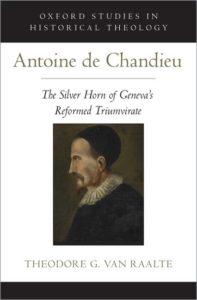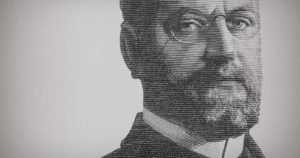
Author’s Corner: Oxford Studies in Historical Theology
Each week on Credo we welcome you to join us in the Author’s Corner where we will meet a set of authors whose recent books deserve your attention and might even help you grow in your knowledge of theology, history, philosophy, and the scriptures. We hope the Author’s Corner can keep you up-to-date on the most important books published today and where you can find them.
On today’s Author’s Corner, we present you with a selection from the Oxford Studies in Historical Theology, edited by Richard A. Muller (Oxford University Press).
Oxford University Press established in 1994 a new series of original monographs devoted to the history of Christian thought from its early and medieval beginnings to its later development in the modern period. The underlying assumption held from the first was that Christian ideas from the past can best be understood when scholars present them in their proper historical and cultural context. For 20 years the distinguished authors in this series have treated a wide variety of intellectual problems from the Christian past and, by so doing, have redefined the discipline of historical theology for the foreseeable future.
A ntoine de Chandieu: The Silver Horn of Geneva’s Reformed Triumvirate (OUP, 2018) by Theodore G. Van Raalte
ntoine de Chandieu: The Silver Horn of Geneva’s Reformed Triumvirate (OUP, 2018) by Theodore G. Van Raalte
Offering the first study in any language dedicated to the influential publications of the French Reformed theologian Antoine de Chandieu (1534-1591), Theodore Van Raalte begins by recalling Chandieu’s reputation as it stood at the death of Theodore Beza in 1605. Poets in Geneva mourned the end of an era of star theologians, reminiscing about Geneva’s Reformed triumvirate of gold, silver, and bronze: gold represented Calvin; silver Chandieu; and bronze Beza. Van Raalte’s work sets Chandieu within the context of Reformed theology in Geneva, the wider history of scholastic method in the Swiss cantons, and the gripping social and political milieux of this tumultuous time. Chandieu was far from a mere ivory tower theologian: as a member of French nobility in possession of many estates and castles in France, he and his family acutely experienced the misery and triumph of the French Huguenots during the Wars of Religion. Connected to royalty from the beginning of his career, Chandieu later served the future Henry IV as personal military chaplain and cryptographer. His writings run the gamut from religious poetry (put to music by others in his lifetime) to carefully-crafted disputations which saw publication in his posthumous Opera Theologica in five editions between 1592 and 1620. Chandieu had developed a very elaborate form of the medieval quaestio disputata and made liberal use of hypothetical syllogisms. Van Raalte argues that Chandieu utilized scholastic method in theology for the sake of clarity of argument, rootedness in Scripture, and certainty of faith.
A ugustine on the Will: A Theological Account (OUP, 2019) by Han-luen Kantzer Komline
ugustine on the Will: A Theological Account (OUP, 2019) by Han-luen Kantzer Komline
This book provides a framework for Augustine’s understanding of will, an aspect of his thought that has proven to be both essential and inscrutable. On the one hand, the Augustinian will is everywhere. It comes up constantly both in Augustine’s thought and in the massive literature engaging it. The will is impossible to avoid in almost any treatment of any aspect of his thinking, whether theological, philosophical, psychological, or political, because it is at the heart of his understanding of the human person and therefore vital to his understanding of such diverse topics as grace, freedom, the image of God, and moral responsibility. On the other hand, Augustine’s understanding of the will resists direct examination. With the exception of an early treatise on free choice, Augustine never devoted a work to exploring the will in a programmatic way. Likewise, while the Augustinian will is constantly invoked in secondary literature, it rarely receives analysis in its own right.
Han-luen Kantzer Komline demonstrates that Augustine’s view is “theologically differentiated,” comprising four distinct types of human will, which correspond to four different theological scenarios. Augustine’s innovation consists in distinguishing these types with a detail and clarity unprecedented by any thinker before him. This account of the Augustinian will gives a comprehensive picture of the development and mature shape of Augustine’s thinking on this vital yet perennially puzzling topic.
T he Regensburg Article 5 on Justification: Inconsistent Patchwork or Substance of True Doctrine? (OUP, 2019) by Anthony N. S. Lane
he Regensburg Article 5 on Justification: Inconsistent Patchwork or Substance of True Doctrine? (OUP, 2019) by Anthony N. S. Lane
The question of the justification of sinners is one of the most complex regions of Christian theology. The Regensburg article on justification proposed a solution that it was hoped would be acceptable to both sides, Protestant and Catholic. In 1541 at the Regensburg Colloquy, three leading Protestant theologians (Melanchthon, Bucer, and Pistorius) and three leading Catholic theologians (Eck, Gropper, and Pflug) debated with the aim of producing a commonly agreed statement of belief. The colloquy as a whole eventually failed, but it began with a statement on justification by faith agreed by all the parties, Article 5″, leading to an initial burst of optimism. There were two contrasting reactions to Article 5. Some, like Calvin, maintained that it contained the substance of true doctrine; others, like Luther, called it an inconsistent patchwork. These two rival assessments have persisted over the centuries.
The aim of this book is to decide between them. It does so by viewing the article in the light of the publications of the key participants and observers, as well as by comparing it with the Tridentine Catholic Decree on Justification. Anthony Lane puts the Regensburg article under the microscope, offering both a wide-ranging study of the article’s history and a line-by-line analysis of its content, presenting the original Latin text together with an English translation and running commentary.

